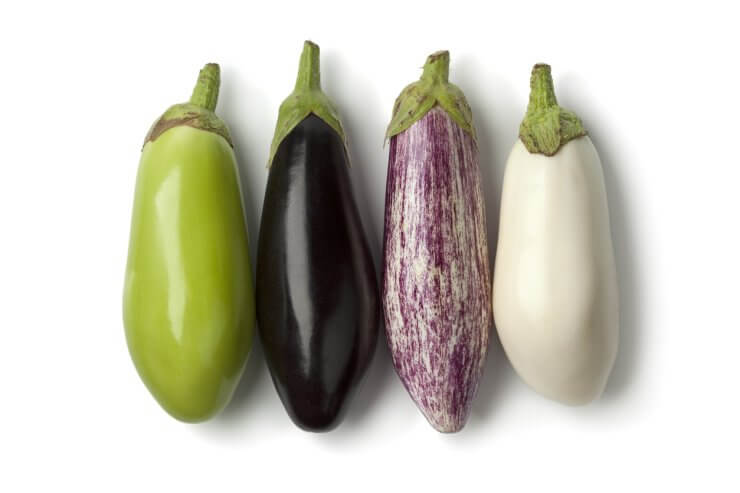
Variety of fresh eggplants
What gardeners in the U.S. and Canada call eggplant, the rest of the world calls aubergines, brinjals, guinea squash, and the list goes on.
The term eggplant comes from its obvious egg-like appearance, though there are many types of eggplant that are not quite so bulbous.
In fact, there are two types of eggplant: long and round. The long, skinny eggplants tend to be sweeter and less bitter than their egg-like counterparts. There are also large eggplants and small or baby eggplants. Smaller eggplants are perfect for indoor and hydroponic gardens, while larger eggplants thrive outdoors where they can spread out.
When you think of eggplants, you probably think of purple, white, or pink, but they can also be green and even red. Most of the time, eggplants are harvested before they reach those peak colors, which signify their ripeness. Still, their bright colorful purple and white flowers are welcome in the garden, attracting pollinators from every corner of your yard,
Mostly eggplants differ by shape and size. Here’s an overview of the three types of eggplant common among home gardeners:
- Long or slender varieties have a mild flavor and tender flesh. Both Japanese and Chinese eggplants tend to be long and slender in shape. Japanese eggplants tend to be darker than Chinese eggplants, which are often more lavender-purplish. They both have a nice, thin, skinless, seedless, and creamy flesh. They’re especially good when grilled or used in stir-fries, but you can use them in any way you’d normally use eggplant.
- Round varieties, your standard eggplant like the Italian eggplant or the large Black Beauty, is what you’re likely to find most easily at the grocery store. They have a slightly sweet taste and firm texture. They are good for cooking and baking because they hold up well when sliced or diced. You’ll also find white and green eggplants in this style, but the only meaningful difference is their color.
- Baby or miniature varieties are much smaller than standard sizes, usually no more than 1 to 2 inches across. Their size makes them ideal for small spaces—they will grow quickly and take up very little space. You can plant any number of these babies within a single pot or container. Fairy Tale eggplants are one varietal that will fit in the palm of your hand, and taste great straight from the grill because of their tenderness. Another type of baby eggplant is the Indian eggplant which is a little bigger and can be stuffed.
You’ll find plenty of varieties of eggplant seeds available at seed companies and garden centers. Ask your local extension center which type of eggplant is best suited for your gardening needs.
Which type of eggplants have you grown? Do you have a preference? Please share your opinion.


 Previous
Previous

